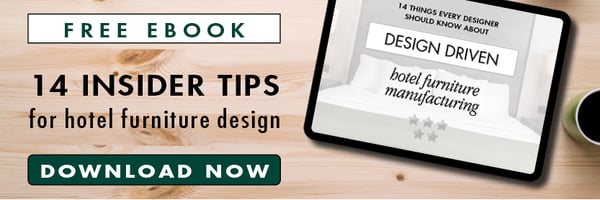
Selecting guest room furniture can be challenging, no matter what style you go with. Finding pieces that not only align with your desired aesthetic but also resonate with your guests.
However, selecting the right furniture hinges on understanding hospitality furniture specifications.
These specifications play an important role in guaranteeing that the furniture meets your functional needs and improve the overall guest experience.
By clearly defining these specifications with your hotel furniture manufacturer, you can streamline the process, avoid issues, and create a comfortable and inviting atmosphere that reflects your hotel’s character.
5 Key Hospitality Furniture Specifications to Consider
Picking the right furniture isn’t just about finding something that looks good – it’s also about making sure it fits your needs and works well in your space. It’s easy to overlook these details, but they can make a huge difference in both function and durability. By focusing on these five specifications, you’ll avoid common pitfalls and make a more informed choice:-
ADA Regulations
-
Materials
-
Technology
-
Architectural woodworking standards
-
Warranty
Understanding these details and talking them over with your manufacturer can help make sure your choices meet both your functional and aesthetic needs.
Here’s a little bit more about why these specifications are important:
1. ADA Regulations
In 1990 the Americans with Disabilities Act (ADA) established a series of accessible design requirements for the construction of hotels and other lodging facilities that apply to the design of ADA hotel rooms.
An experienced casegoods manufacturer will explain to you that your choice of furniture and how it’s incorporated into your hotel design plays a vital role. For example, we know that space is already at a premium in the hotel industry. Your design will need to meet the following criteria for guests using wheelchairs or other mobility devices:
Entrances to guest rooms and restrooms with at least 32” of clear passage and 54” of space on both sides of the door for 360 degrees of rotation
-
Beds, chairs, and other furniture situated with at least 32” of clear passage for mobility
-
Beds 20-23” in height from the floor to the top of the mattress
-
Unhindered access to electrical outlets and data ports without stooping, kneeling, or reaching
Before you open your doors, make sure you’re in compliance.
2. Materials
Selecting appropriate materials and finishes for your guestroom casegoods require considering more than just aesthetics. Hospitality furniture specifications for any high-traffic, commercial setting must be:
-
durable,
-
functional,
-
and meet budgetary needs of the project.
Note: While the more durable material may be the more expensive one, ultimately if you are getting more years out of your casegoods than you would by choosing the cheaper material -- you are saving both time and money.
3. Technology
The demand to incorporate technology into today’s furniture specifications is more complex than ever. From smart guestrooms to robot concierge service, keyless entry to green technology, one thing is for sure, guests want access.
And while it may require a pricey initial investments for hoteliers, the financial rewards are vast.
So, what can you expect to provide? While nobody can predict the future, current trends that have been picked up by millennial influencers can point us in the direction of where guests' demands will be within a decade or two from now.
4. Architectural Woodworking Standards
Designing and purchasing hotel guestroom casegoods that not only appeal to your target guest demographic while meeting the industry standards for functionality, can be overwhelming.
The Architectural Woodwork Institute (AWI) is the hospitality industry expert on wood product quality, and the gatekeeper of functional and aesthetic woodwork standards. It is important that you ensure the quality of your hotel furniture by presenting AWI standards, for your specific project, as guidelines for your manufacturer:
AWI Grades of Work include:
-
Economy Grade specs mean you’re getting the minimum requirements for workmanship, materials, or installation.
-
Typically applies to wood products that are out of public view, so your hospitality furniture should not fall into this category.
-
Custom Grade is specified for most high-quality wooden hotel furniture. Custom-level specs give a designer more wiggle room in their concept.
-
Premium Grade is reserved for high-use and high-profile furniture and casegoods. Specifying Premium Grade woodwork means you’re getting the highest quality materials, production, and/or installation.
5. Warranty
In the hospitality industry, reputation is everything and competition is fierce. Providing exceptional service and a high-quality product only gets you the opportunity; it is what happens after the product is installed that makes a lasting relationship.
A guestroom casegoods manufacturer should not only engineer and manufacture commercial-grade products for your hotel, they should abide by the industry standard, 5-year warranty. Ideally, you’ll never have to use it. But a hotel furniture warranty is a critical piece to your hospitality design project.
|
What are some practical tips for ensuring ADA compliance during the design and installation phases? To ensure ADA compliance during the design and installation phases, start by consulting with an accessibility expert or designer who specializes in meeting these regulations. Conduct a thorough review of your design plans to confirm that all dimensions, such as door widths and turning spaces, meet the required standards. During installation, double-check that all furniture placements allow for clear passages and that accessibility features, like lower light switches and accessible outlets, are correctly installed. Regularly review compliance with ADA guidelines throughout the process and conduct a final inspection before opening. How can I balance the need for durable materials with aesthetic considerations to maintain the overall guest experience? Balancing durability with aesthetics involves selecting materials that offer both functionality and visual appeal. Look for high-quality materials that are known for their durability, such as engineered wood or certain composites, and choose finishes that can withstand heavy use while still enhancing the room’s design. Collaborate with designers who can help integrate durable materials into your desired aesthetic without compromising style. For example, a sleek laminate or high-pressure laminate can offer durability while still looking sophisticated. Ensure that the materials chosen align with your hotel's brand image and guest expectations. What are the potential consequences of not adhering to architectural woodworking standards for maintenance and guest satisfaction? Failing to adhere to architectural woodworking standards can lead to several issues. In terms of maintenance, poor-quality craftsmanship or substandard materials may result in premature wear and tear, leading to frequent repairs and higher long-term costs. This can also impact guest satisfaction, as they may notice imperfections or experience discomfort due to poorly constructed or poorly finished furniture. Not meeting these standards can affect the overall perception of your hotel’s quality and may lead to negative reviews or decreased repeat business. |
Secure Your Hotel’s Success with the Right Furniture
Choosing the right furniture for your guest rooms is more than just a design choice – it’s about the safety and well-being of your guests as well. By carefully selecting pieces that blend style with practical needs, you set the stage for a memorable stay. Working with a skilled furniture manufacturer helps you navigate this process smoothly, leading to happier guests and a hotel that stands out.
(This article was published in 2019 and was recently update to reflect current industry trends.)


